Our minibus driver from the border of Bolivia was a super friendly older guy. He even briefly stopped on the road for us tourists to catch a glimpse of a desert fox. I appreciated this as it was an animal we hadn’t seen before, and if he hadn’t stopped to point it out, I probably wouldn’t have then either. It was small and greyish, blending with the surroundings perfectly. No wonder the flamingoes set up their nests so far into the lagoons! After that brief bit of excitement, everyone decides to get off at the next stop, leaving just James and I on the minibus. I know our hostel is about 20 mins walk out of town, and at the peak heat of the day, in the middle of the desert, any closer we can get to it will be a bonus for our weary bodies. I ask him where the bus finishes, and he offers to take us the whole way there. Our hero!
We arrive to our next hostel, Rafa’s House, to a guy walking out the door… “James right?” he says knowingly. “Yeah?”. And he’s gone. We walk through behind him and find 3 more guys sitting in the reception office blazing up. Again we get, “James?”. It seems they’ve been expecting us! We never did figure out why the excitement of our arrival. Feeling a bit bad to interrupt their session, one of the guys nevertheless shows us to our room and around the place, which is hippy-chic decorated with upcycled items galore. Our private room with en-suite is a welcome sight as we’re pretty exhausted from the many early mornings, and I’m still not able to eat anything without facing unwelcome consequences.

As is the cute, cuddly and playful Canela (Cinnamon):

The first thing we notice in the room is that everything starts electrocuting us, especially each other! The sheets crackle with static, the blankets more so. This continues on to the extent I see a spark fly as I touch a wooden crate! A quick Google for how to de-static yourself suggests touching two metal items together, just instantly zaps with the first metal item. As far as we could guess, the extreme lack of humidity in the air, alongside synthetic bedding, made the perfect combination for generating static, and James and I were perfect conductors for it. This led to much ‘fun’ for one of us teasing and threatening zaps at any moment, and my trying to find different ways to turn the metal bathroom door handle in an effort to avoid the inevitable zap (including using James’ neck pillow!), but never managing to avoid the hit. If anyone can explain this phenomenon, I would love to know more, (we have now seemingly developed a fear of metal door handles through some form of unintentional aversion therapy).

Anyway, aside from getting electrocuted, the hostel had a great chilled out vibe (maybe inspired by a certain plant of choice) and a good kitchen for us to try and save some money with cooking. But first, we had to find some money! New country = instantly broke. Back to figuring out exchange rates, which ATMs to trust and what’s cheap/expensive relative to the new economy (everything is expensive relative to Bolivia). We also needed to know how much the excursions would be to know how much to withdraw. With much research done at the hostel on wi-fi, we set off on the walk into town to tick things off the list. I’m in love with the green trees behind clay walls after days being in the arid emptiness of Uyuni.
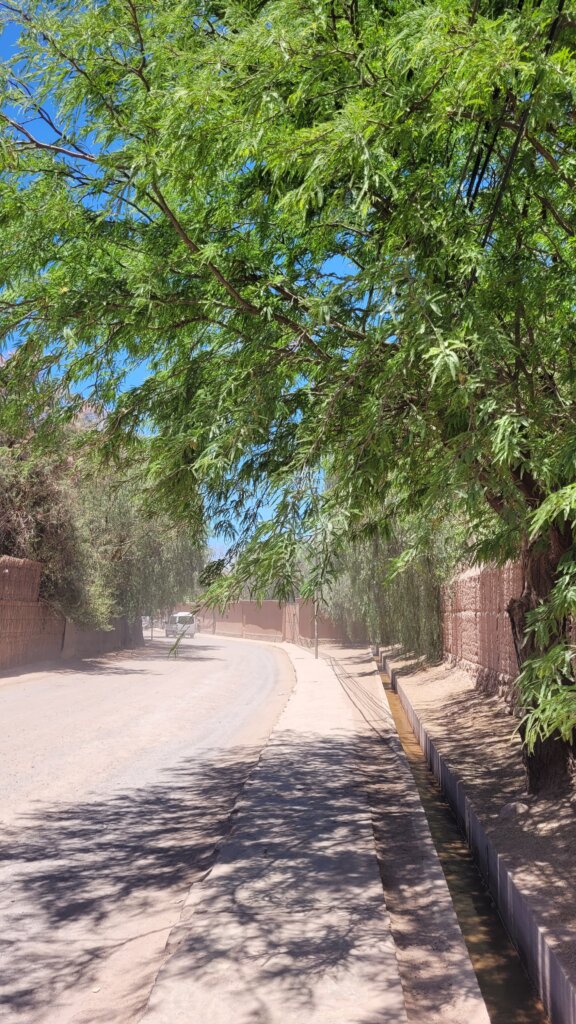
First thing we notice on the walk is that we’re surrounded by deep red rocks on one side, and the amazing volcanic Andean cordillera on the other. What Walter had pointed out to us before as a volcano that can be summited on the Bolivian side (because you’re higher up and therefore there’s less to ascend), we see now why you wouldn’t attempt it on the Chilean side. It’s similar to Misti in Arequipa, as this amazing ever-present backdrop wherever you go.

We’re staying in a ‘newer’ part of town so most of what we walk past is housing. We hop from shadey bit to shadey bit until we make it into town. Town being (pretty much) one main single-track road full of people walking, cycling, hawking, eating ice-creams, or promoting their tour company or restaurant. It’s cute, it’s quaint, it’s dry, it’s hippy-esque, it’s chill, it’s tourist-central, but it doesn’t feel forced like in Cusco. After a bit of a reccy, we figure out how much money we’re going to need, balk and refuse the £8 charge to use one of only 2 cashpoints in town, and are grateful for the only slightly less offensive £5 charge to use the other. Context is everything.
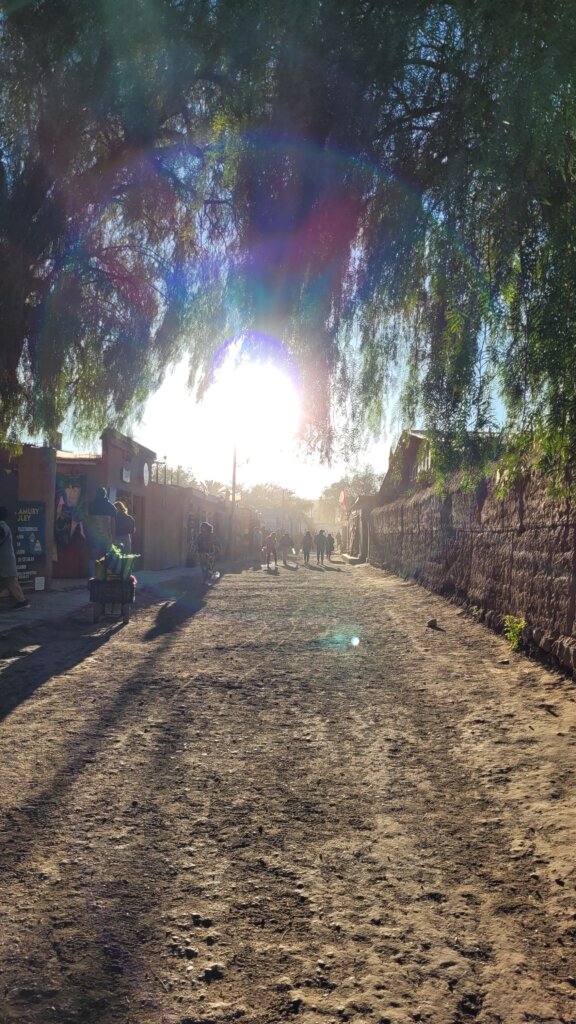
We reward ourselves with a lovely lunch that is our first bit of ‘quality over quantity’ since leaving Lima. James has a chicken caesar salad and pisco sour ‘to start’ (genuinely, pisco sour was on the menu as a starter), with chicken stir fry for main, whilst I brave a salmon with rice for main. It’s the first bit of real food I’ve had for days, and it tastes so good (unfortunately I pay the price almost instantly). Fed, watered, more research done, we go for the best rated tour agency in town (Horizonte), and meet a hilariously bubbly Victoria who books us in for our tours for the next few days. She tells us the agency was started by a couple of Frenchies whose focus is on service, and we can attest to this now that they know what they’re doing. With me back in pain, some food to cook for dinner acquired, and a 1.5 litre bottle of red wine in the bag, we head back to relax and recover.
Day 1 Valle de la Luna
Unlike other locations, the excursions we’re doing here are only half day tours, and the latter half of the day at that, so we get to enjoy our mornings having a leisurely breakfast in between bouts of static shocks. The rest is much needed for me and the stomach cramps finally start getting less and less. Horizonte tours are as organised as expected, and show just how it should be done. We all get thrown into a WhatsApp group giving us the information we need for the day, in 3 languages, what time we can expect to be picked up, our guide’s name Sergio, and his live location to track where he is in relation to us. We’re first up, and Sergio greets us heartily as we jump into a lovely air-conditioned minivan. Sergio is from Santiago, but hates cities, and needs to be able to see the nature around him, so San Pedro is his chosen home. We do the rounds of town picking up everyone else (including another French family with 3 children (HOW?!)) before we make our way out of town to start the tour. Sergio gives us a brief intro to the area and what we’re about to see and do. I like this company! We’re taught how this area was layered with lava from the volcanoes, and water from the sea. They would ebb and flow and layer over each other, creating visible layers of various minerals and types or rocks, such as gypsum (calcium sulphide), clay, and salt (sodium chloride). As the plates moved, these layers were pushed up and out of the ground, Sergio explains, like the edge of a book being pushed into itself, creating these folds and opportunity to see the layers of our earth’s history before us. There’s apparently no way to carbon date the minerals, so scientists estimate the age through the number of these layers. As is a theme now with our photos, they can never capture the scale and beauty of what we’ve been so privileged to experience. The minivans look like micromachines by comparison.

The sand is just the rocks around us blown into dust by the unstoppable wind:



Next up, we’re off to an old salt excavation site (although they called it a mine). The red-brown ground starts to glisten around us, as we notice a thin layer of white starts becoming more prevalent as we walk along. It’s as though someone has dusted the area with icing sugar or snow, with tiny crystallised formations sprouting from the ground.
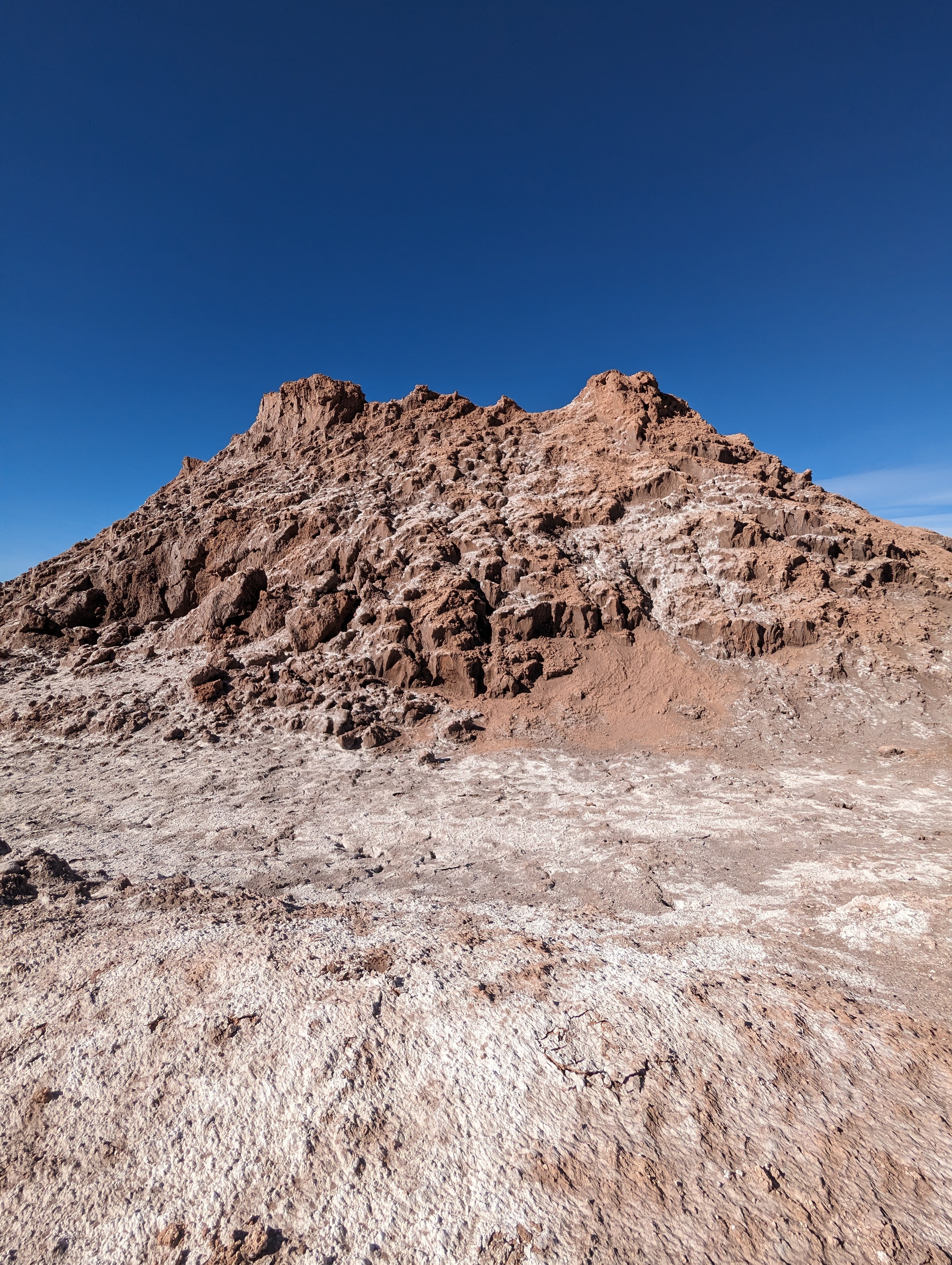
Sergio explains to us that his happens from the water under the surface mixing with the salt below us. The water rises through the layers to the top, where it evaporates, leaving the salt behind (I’m sure we did something like this for a science experiment at school!). We see the remains of what was the lodging of a family who would extract the salt, but the purity was quite low. As soon as they found the pure stuff to the north in a massive salt flat, their business went south but Sergio reassures us that tourism came along and saved the day… hmm.

Our last stop on the salt stint is to a giant salt rock wall where you can apparently hear the salt cracking if you remain silent. It seems that trying to get 30 tourists (especially 3 children) to literally not move a muscle for a few minutes is impossible as people shuffle their feet in the sand, and take photos with their cameras that make the shutter noise. Nevertheless, we think we hear a few hints of pops and cracks, but my expectations of the cracking of an ice-berg are (unsurprisingly) completely off base. Sergio maintains his friendly and positive demeener, despite the clear ineptitude of his latest group, and leads us to our next stop.
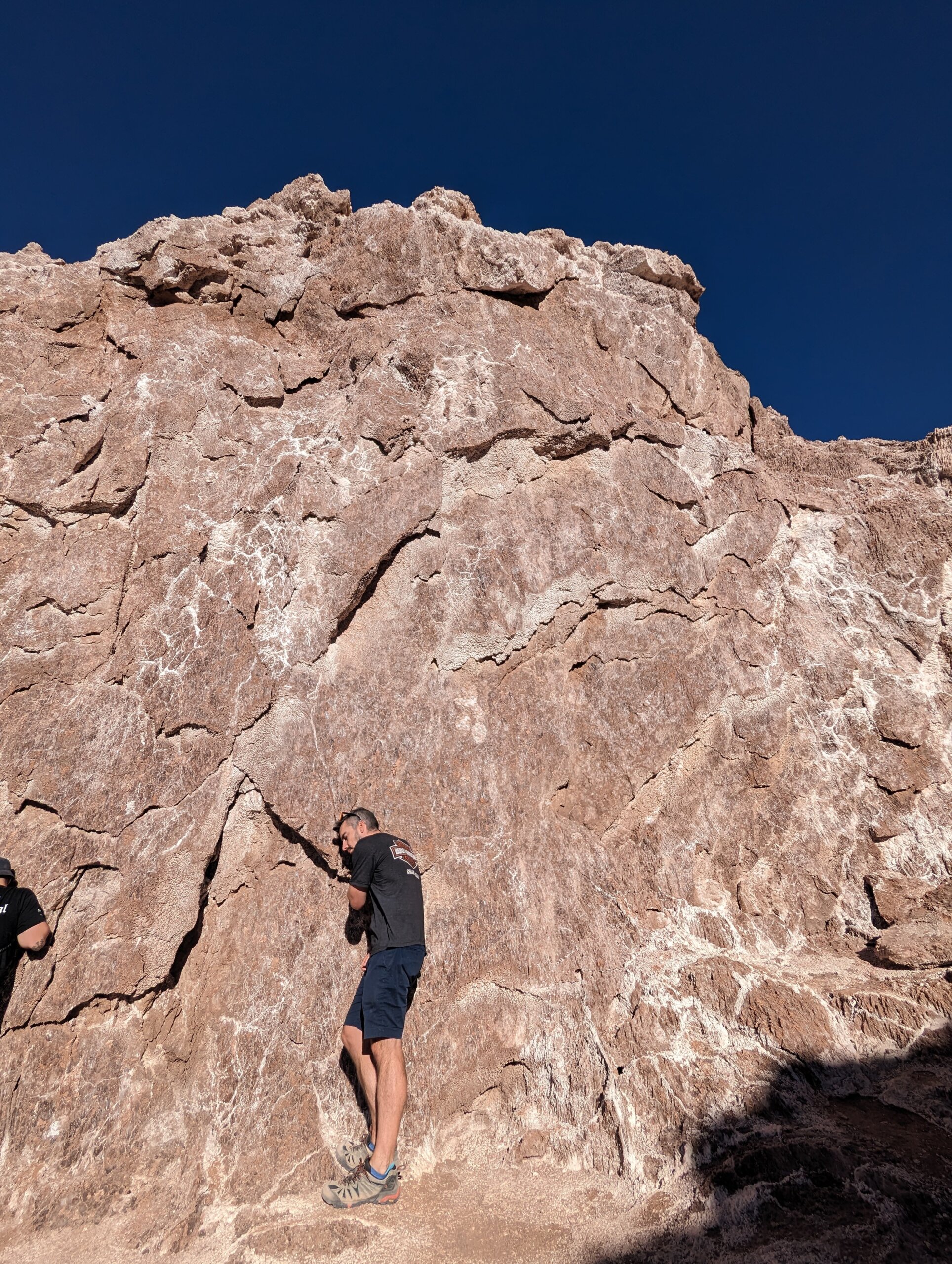
Now, the ‘amphitheater’. Less an amphitheater, more a giant sheer rock-face in a curved shape. Whatever it looks like, it’s an impressive site, before our van picks us up to take us to a viewpoint.


Next up, this viewpoint allows us to see the mountain range that stops any water getting to this region, the Andes that provide stunning backdrops, and a birds eye view of the various rock formations of the area. We’ve seen a lot of rocks and formations and volcanoes, but they always seem ever so slightly different, and no less impressive and fascinating.
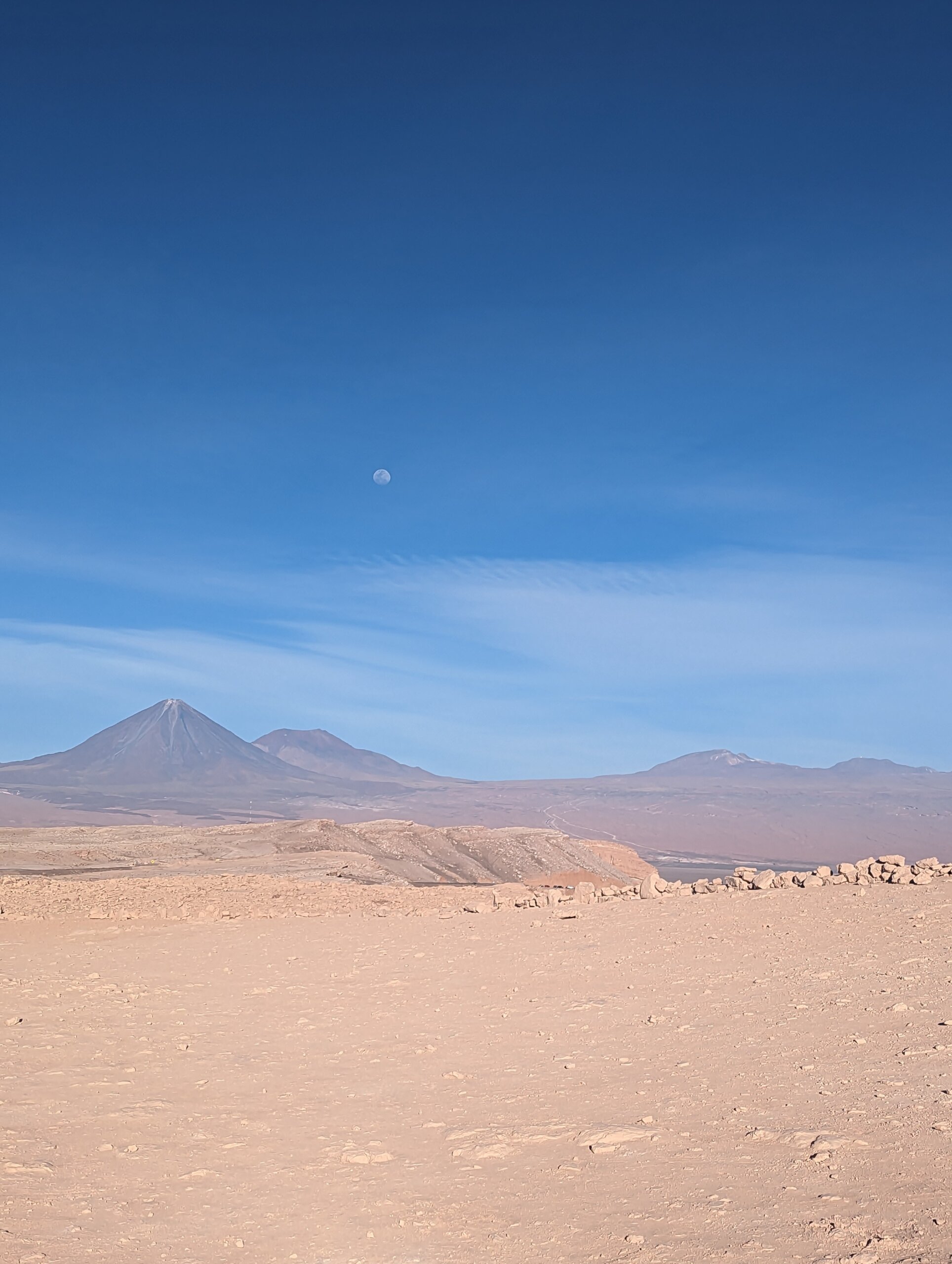


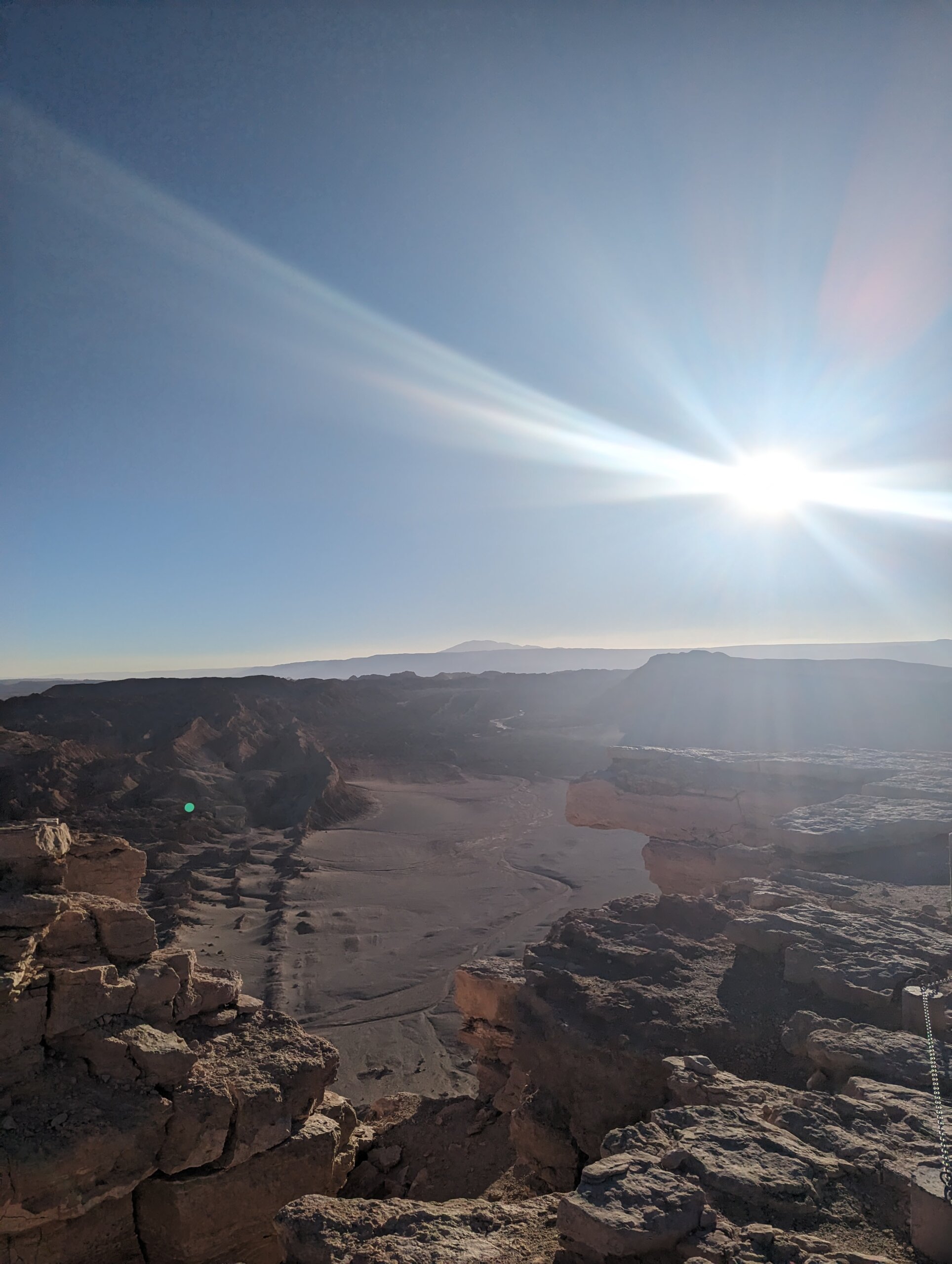
As the sun begins to lower around us, it’s time to get into our minibus for our last stop, to have a snack and a cocktail as watch the sun go down. We pull up to another viewpoint, and are told to have a wander as Sergio and crew get things setup. We come back to find an amazing spread with pisco sour (chilean style though… no comment), crisps, crackers, cheese, olives, fruits, nuts, tomatoes, salami… the pick-meal dream! We all descend like vultures and as we chat to another British couple about Patagonia, almost miss the star of the show. We quickly hop over the rocks to watch the sun set beautifully as we clink our (fake) pisco sours as a toast to the wonderful sight and day we’ve had.

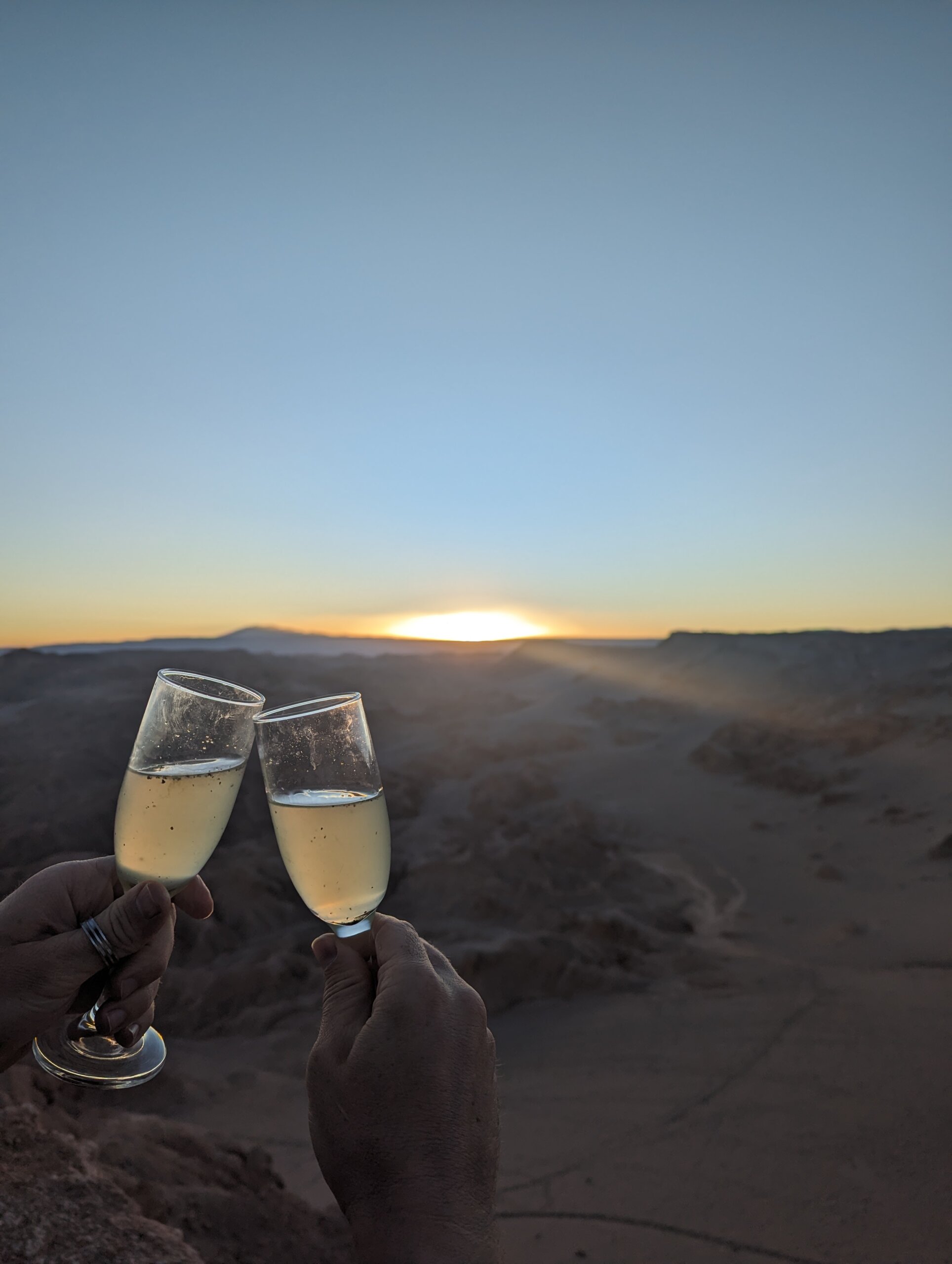
We’re then ferried back to town where we head for dinner, a highly rated pizzeria, and I continue to test my will vs stomach as we have a half hawaiian, half Mexican pizza. It hits the spot perfectly and we head back satisfied for (what we hoped would be) and early night.

Unfortunately, the latest guests and hostel worker have other ideas, and have a jolly good night of it until 1:30am. Such is hostel life.
Day 2 Laguna Cejar Tour
After a morning of more zapping, passive-aggressive glares at our hostel-mates, the weirdest meal we’ve probably ever made so far, it’s time for Tour 2. Our guide today is Pedro, a Brazilian who loves metal and misses proper live music. After doing the rounds to collect everyone again, we’re heading south this time to some lagoons. He gives us a much belated tip, to not lick our lips when they are dry, this only makes it worse as the wind and heat evaporates the moisture leaving cracks. Bring on the lip balm! We first have a wander around a deep blue lagoon, with some obligatory flamingoes living their best lives, to enjoy the incredible colour palette we have grown familiar with from the Uyuni side. Unfortunately, today seems to have brought in almost gale-force winds, and there’s little I can hear of poor Pedro trying to tell us things, as the wind quickly whips away whatever is said. It’s also pretty darn cold, not something we were expecting at all. Pedro tells us that this is very unusual for the area, I guess we can’t always be lucky with the weather. Nevertheless, it’s still beautiful, and we enjoy the view, before we walk over to laguna cejar.

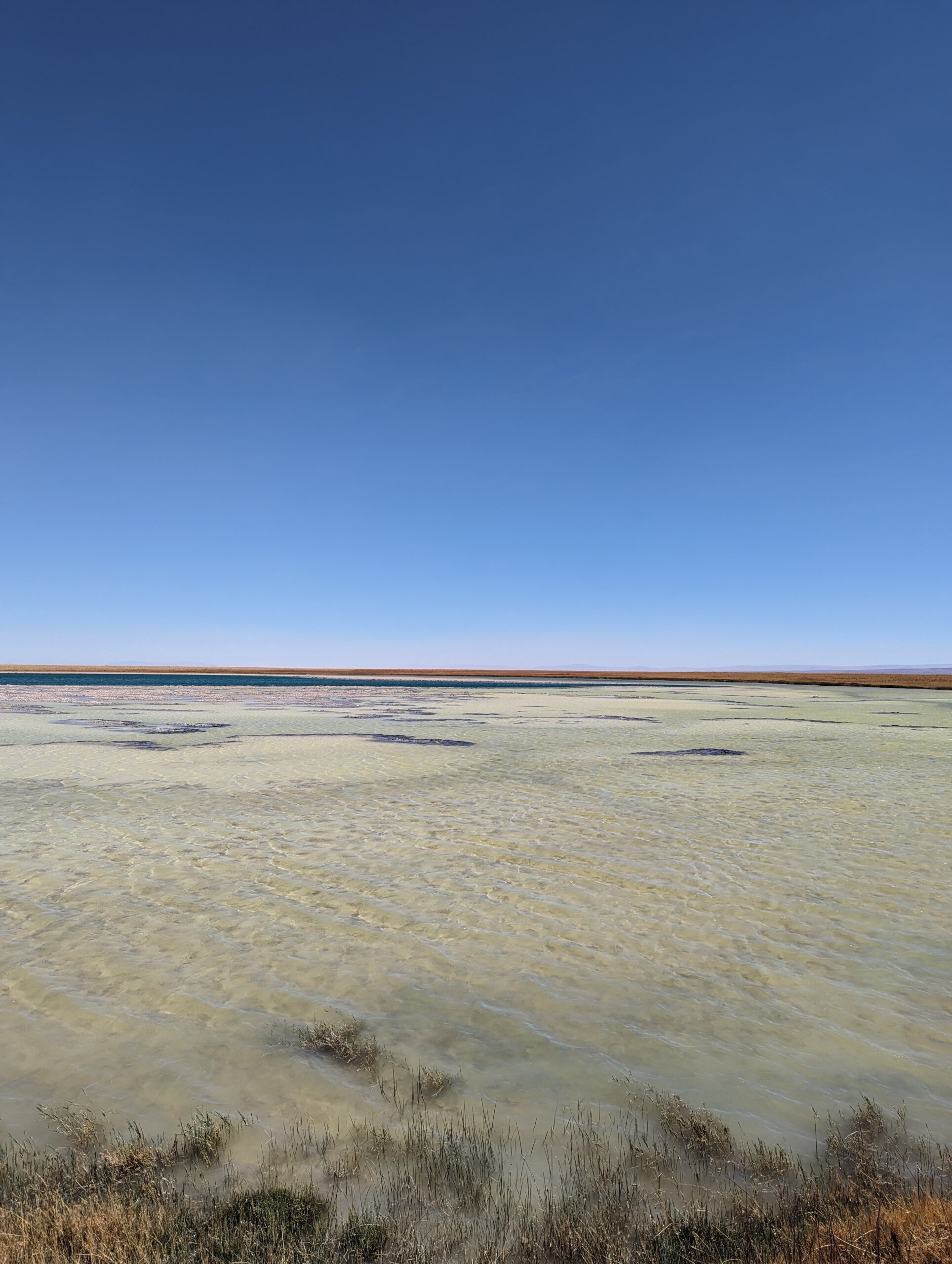
Laguna Cejar is a salt lagoon, but unlike the sulphuric or arsenic or other dangerous minerals contained in the lagoons we’ve seen up to now, we can actually get in this one!

The wind makes the idea somewhat less inviting, but we are here and here we must.

We all strip off in the cold, blustering wind, and gingerly tip-toe into the (equally) cold water.

Once the shock of how cold we are inside and out of the water subsides (or does it) we realise our instinctive reaction to tread water is needless. That our feet are floating up behind and in-front of us, almost ducking our heavy heads under the water. We can just stand in the water as it holds us up. Or float without a care. It’s not like anything either of us have ever experienced, as I feel a bit like I’m in space or some kind of statis or weightlessness. It’s amazingly weird.


As the wind continues to whip salt-water waves into our faces, we brave the exit as we wrap our towels around us like capes as the wind and sun quickly dries us off. We quickly realise we now resemble the ground from yesterday, as the water has evaporated leaving a layer of salt all over us. Time for the outdoor showers then! As we turn the taps and wait eagerly for the water from the above, we look up to find nothing, as the wind is blowing so strongly that no sooner does it come out the tap, that it is blown straight away. After a few futile attempts of washing off in the moments the wind died down and the drips turn to a splosh of water, I start getting too cold and we give in and just get dressed. It is only as we stand in the sun hoping to absorb some of its heat before the wind also blows that away that we realise there were sheltered showers on the other side. Literal facepalm.
Jumping back into the relative warmth of the minivan, we’re onto our next stop, the Ojos de Salar. These are two sinkholes in the salar, with the road in between, and the volcanoes in the background. We’re not 100% sure the appeal of this stop, but the rest of the groups are going wild for photos with them. I hide in the minibus, but not before the door almost flies off as I try and clamber in and I can barely close it behind me due to the wind strength! The stops are clearly not lasting as long as usual, as the salt-covered, short and t-shirt clad tourists quickly dart around to get their shots and make it back into the minibus in record time.

We have one last lagoon to see, that contains our evolutionary ancestors. I’ll be honest that at this point I was so cold I have no recollection what Sergio told us, so here’s a sign and photo:
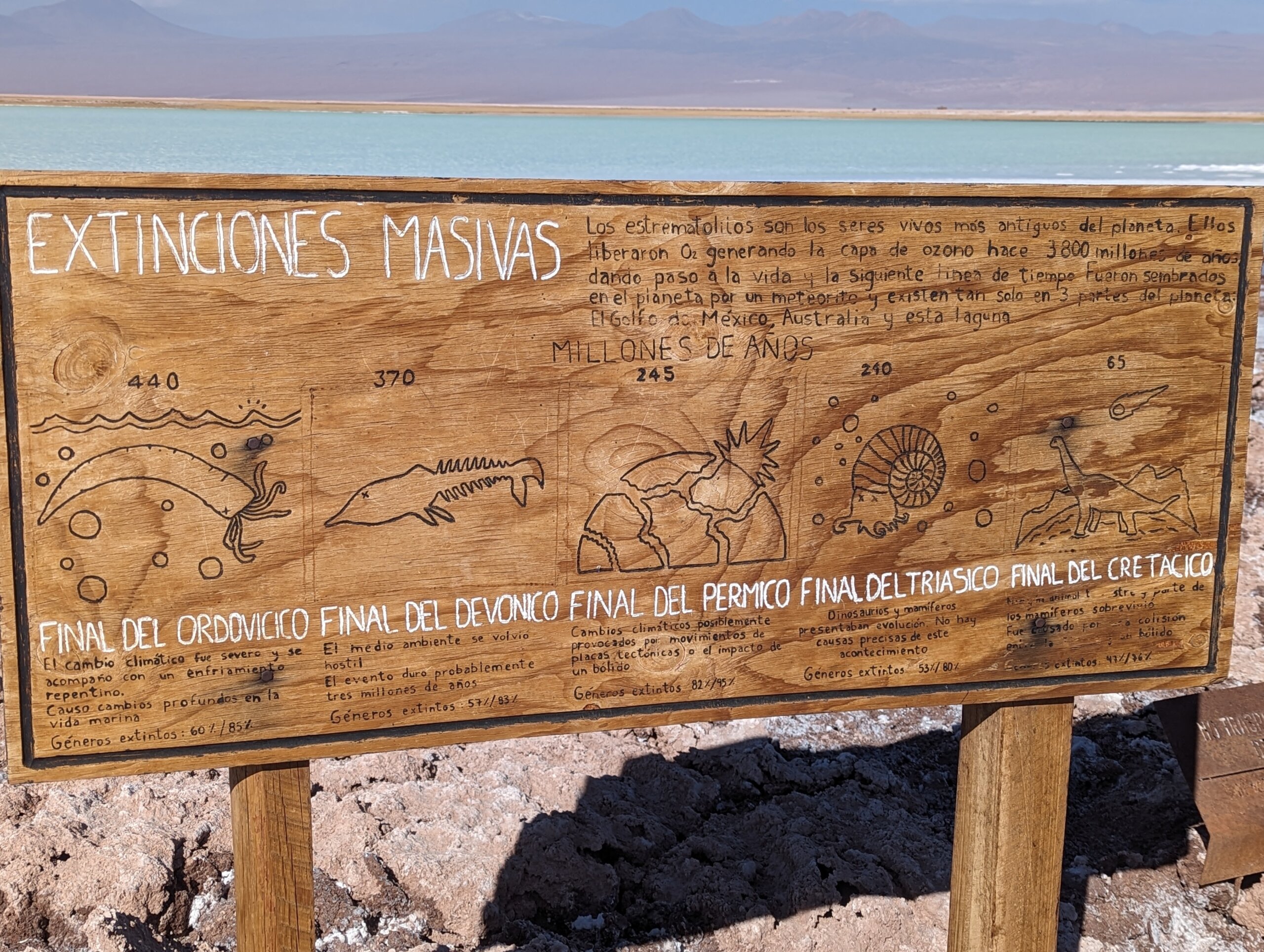

With the sights seen, it’s snack and cocktail time! We know what this means, although we have no idea how they’re going to find somewhere in this vast, flat, nonethingness to shelter us and the precious snacks from the wind. But we’re merely amateurs. Our driver knows where to go. Due to us speeding through the other stops, we have time to go a little bit further afield, and we drive towards an area with some big, fluffy ‘trees’ dotted about. Behind them, are minibuses, all hiding out from the wind to feed their passengers. We find our spot, and the tree turns out to be a giant version of a spikey but floral bush that we’ve seen across the altiplano. Instructed to wander off, but not too far, whilst they get things setup, I welcome the shelter from the wind, and the chance for my body to return to normal temperature at last.

The spread is as good as the night before, as we take it in polite turns to grab what we can before making space for the next person to do the same, and wait for the ‘appropriate’ amount of time before we go ahead again in a bid to not seem like the greedy ganets we are. We chat with Pedro about music as he skips through the USB he’s found of rock hits that aren’t meeting his approval. One way or another, he knows that an empty pisco sour glass is not something the Brits will tolerate, and we get more than our fair share. As the food runs dry, we call it a day, and head back to the warmth and shelter of town.

It’s our last night in San Pedro, so I’ve found us another well-reviewed eatery that we head to. There’s a queue despite how big the place is, but it moves quickly. We get a table and choose chicken with mushroom sauce and chips for James, and chicken a la pobre (with egg, onions and chips) for me. The portions are HUGE, especially after all our snacks from the tour, so we’re very pleased to find out we can package the leftovers up and take them with us for lunch tomorrow. This evening, the party is seemingly not in our hostel, so we actually manage to get a good night sleep (after trying to finish off the 1.5 litre wine and failing), and I don’t wake up in the middle of the night for my usual electric bathroom experience. Sweet sweet sleep.
Day 3 No More Days of Static
Our last day in San Pedro starts chilled as before. A leisurely breakfast and we start to pack up. On the trips into town, we had seen many an ice-cream shop, but I was either too ill or cold to have one. Today would be the day! We did the 40 minute round trip, tasting a variety of odd and interesting flavours, to settle on tiramisu + brownie for James, chocoloco and quinoa de leche for me. James’ choice was the definite winner, but I was determined to try something different and new (thankfully he also gave me half of his so I didn’t completely lose out).

After a stop at the shop to get some veg to go with our leftovers from last night, we headed back to try for the millionth time to upload the photos of the salar to the blog, and kill some time.
Lunch inhaled, bags packed, we make the 20 minute walk to the bus station with all our gear for the last time. It’s a slog in the afternoon heat and sun, but the bus is there when we arrive and we’re off to Calama, the main hub of the area that also has the airport we’ll be flying from. The journey is slow, smooth, and only 2 hours, possibly the shortest bus ride we’ve had since we left the UK. On the way we pass huge fields of solar panels and wind turbines, taking advantage of this incredible climate in the best way.

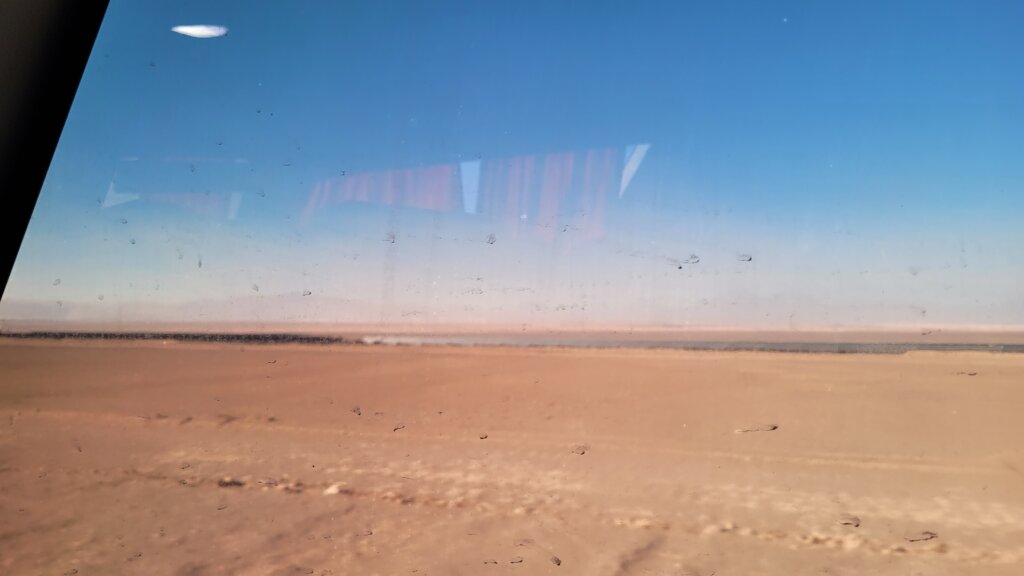
We scramble to figure out how to get a street taxi, and our on our way to the airport after flagging someone down.
As we’re about 2/3 of the way there, I realise something is missing… our tote bag with my jumper, jeans, and crisps for the road. It’s on the bus we realise, and the bus had already driven off before we even got in the taxi. With no working mobile phones, no way to know where the bus went next, only enough money for 1 more taxi journey to our name, our flight leaving in 2.5 hours, we expunge all other ideas to get my warm clothes back, and accept the loss. It’s frustrating (I hate shopping for jeans), but it’s not stuff we can’t replace. I think of Nina (my colleague) who told me before we left about how her whole big backpack got nicked half way through her own backpacking trip. She survived. I can handle a missing pair of jeans and a jumper! So, we take thanks that there was nothing more valuable in there (we don’t think!), and make a note to ourselves that any side bags we have will only ever contain expendible stuff. It’s a lesson I’m glad we’ve learnt now, to only lose some clothes and crisps.

So, that’s San Pedro de Atacama. I admit, I was less than thrilled about us coming to a desert, but it was on James’ must list and so we made it work, and I’m glad we did. It’s been a great little spot for some touristing, good food, relaxation, something different, a bit more moonscape and staring aghast at the bright moon glowing above, before we head south. As with a lot of these places, there’s a charm here I struggle to put into words, but I’ve really enjoyed our time here, to say goodbye to the altiplano, and the driest place on earth.
************
Adventure – wondrous landscapes, not expecting much from tours and getting more. Making dinner in a kitchen full of Latinos.
Excitement – feeling suspended in water in the laguna cejar, being able to eat again! Finding out there’s a schnitzel place with 101 different toppings in Heidelberg.
Trauma – being too nervous to touch the door, wall, bed, shelf, each other for fear of a zapping. Trying to upload blog photos but the Internet being too inconsistent to get anything up. Getting hurried out of our room by the cleaner despite having another hour to check-our. Being kept awake by inconsiderate hostel owners and guests. Realising my warm clothes are now the property of Frontera bus company.
2 Comments
Firstly that dog is so damn cute 😍, great pics. Glad you managed to live through all the zapping 🤣. Sounds like another brilliant Tour Guide and plenty of good fuel I.e Pisco Sours and lovely snacks along the way. I’m only sorry Dave and I didn’t find the place in Heidleberg that had a 101 toppings. The swim in the lagoon sounds amazing, the colour of the skies is a sight to behold 😊. Hope your tum has settled now and look forward to your next blog 😊.
Bravo for going for a swim! That sounded so cold, but such an experience! So impressed with the quality of tours, guides and restaurant food. Great that you seem to be able to eat food again, hopefully you’ve now had a gut upgrade and will be less likely to fall ill again.
P.s. I just finished reading about the other San Pedro in Marching Powder. What a story, I could not put it down! Thanks for the tip!